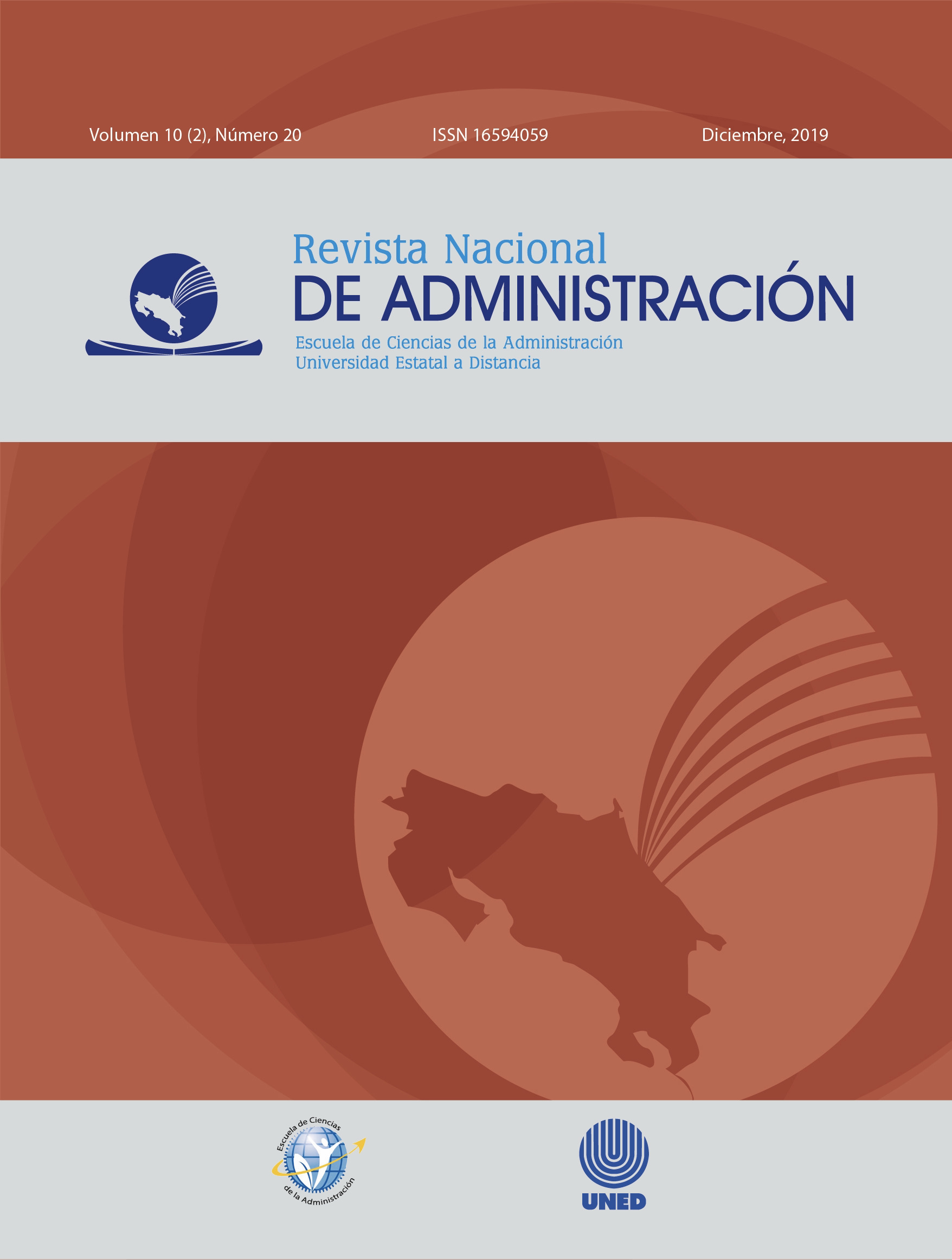GROSS DOMESTIC PRODUCTION IT IS COUPLING WITH THE GREEN HOUSE GAS EMISSION IN COSTA RICA, A LIMITIATION TO MOVE INTO GREEN GROWING
DOI:
https://doi.org/10.22458/rna.v10i2.2733Keywords:
Sustainable growth, economic growth, climate changeAbstract
By means of economic and environmental indicators, an analysis was made as to whether Costa Rica’s economic growth model is or not linked to greenhouse gas emissions. To this effect open database information was collected for the years between 1990 and 2014. According to a logistic regression model, the results revealed that the growth of the gross domestic product and the use of energy in kilogram oil equivalent are significant predictor variables for the variable dependent on the total emission of greenhouse gases. In an occasional analysis from 2008 to 2014, a disconnection was observed, but the analysis must continue until 2018 based on a new national inventory of greenhouse gases. It was concluded that Costa Rica’s growth is historically linked to the total emission of greenhouse gases, which limits a model of green growth.
References
Armeanu, D., Vintala, G. y Gherghina, S. (2017). Does renewable energy drive sustainable economic growth? Multivariate panel data evidence for EU-28 countries. Energies, 10, 381-402.
Boslaugh, S. (2013). Statistic, In a nutshell. A desktop quick reference guide (2da. ed.). Sebastopol: O'Reilly Media, Inc.
Chacón, A., Jiménez, G., Montenegro, J., Sasa, J. & Blanco, K. (2012). Inventario nacional de gases efecto invernadero y absorción de carbono 2012. San Jose: Minae, IMN, GEF, PNUD.
Comisión Europea - Acción por el Clima. (Diciembre de 2015). Acuerdo de París. Recuperado de https://ec.europa.eu/clima/policies/international/negotiations/paris_es
Draghicescu, M. (1 de enero de 2010). Study of correlation between the gross domestic product and the greenhouse gas emissions throughout the European Union by using econometric models. 5th International Conference on Applied Statistics, (págs. 1-12), Bucharest. Recuperado de http://search.ebscohost.com/login.aspx?direct=true&site=eds-live&db=asn&AN=64925019
Dual Citizen LLC. (2016). GGEI: Measuring national performance in the green economy. New York: Dual Citizen LLC.
GGGI. (2015). Accelerating the transition to a new model of growth-GGGI refreshed stratetic plan 2015-2020. Recuperado de http://gggi.org
Greiner, A. (2004). Global warming is a basic endogenous growth model. Evinronmental Economics and Policy Studies, 6, 49-73.
Mardani, A., Streimikiene, D., Cavallaro, F., Loganathan, N. y Khoshnoudi, M. (2019). Carbon dioxide (CO2) emissions and economic growth: A sistematic review of two decades of research from 1995 to 2017. Science of the Total Environment, 649, 31-49.
Martínez, A. y Porcelli, A. (2017). Reflexiones sobre la economía verde. El new deal ecológico mundial. Lex, 15(19), 361-408.
MEIC. (2018). Plan de Descarbonización. Compromiso del Gobierno del Bicentenario 2018-2022. Recuperado de www.minae.go.cr
Millenium Ecosystem Assestent. (1 de marzo de 2005). Living beyound our means. (W. Reid, ed.) Recuperado de: http://www.wri.org/publication/millennium-ecosystem-assessment-living-beyond-our-means
Minae. (5 de diciembre de 2017). Propuesta de política nacional de consumo y producción sostenible 2018-2030. Recuperado de: http://www.digeca.go.cr/documentos/propuesta-de-politica-nacional-de-consumo-y-produccion-sostenibles
Minae. (2018). Plan Nacional de Descarbonización. Compromiso del Gobierno del Bicentenario 2018-2022. Recuperado de: https://minae.go.cr/images/pdf/Plan-de-Descarbonizacion-1.pdf
Moore, F. y Diaz, D. (2015). Temperature impacts on economic growth warrant stingent mitigation policy. Nature Climate Change, 5, 127-131.
OECD. (11 de mayo de 2011). Toward green growth economy. Recuperado de: http://dx.doi.org/10.1787/9789264111318-en
OECD. (2017). Green Growth Indicators. P. OECD Publishing. doi: http://dx.doi.org/10.1787/9789264268586-en
Organización de las Naciones Unidas. (25 de setiembre de 2015). Objetivos para el desarrollo sostenible. Recuperado de: http://www.un.org/sustainabledevelopment/es/objetivos-de-desarrollo-sostenible/
Sánchez, O. y Navarrete, C. (2017). La experiencia de Costa Rica en el pago de servicios ambientales: 20 años de lecciones aprendidas. Revista de Ciencias Ambientales, 51, 195-214.
Banco Mundial (20 de noviembre de 2017). World Bank's Open Data. Recuperado de https://data.worldbank.org/data-catalog
World Resources Institute. (2017). CAIT Climate Data Explorer. Recuperado de http://www.cait.wri.org
Yale Center for Enviromental Law & Policiy. (2014). Envriomental Perfomance Index. Universidad de Yale. Recuperado de http://archive.epi.yale.edu/content/2014-epi-report
Zakir-Saadullah, M. (2013). Causality between economic growth, energy consumption and green house gas emissions in Bangladesh: a Toda-Yamamoto approach. Journal of Academic Research in Economics, 5, 245-257.
Published
How to Cite
Issue
Section
License
Aquellos autores/as que tengan publicaciones con esta revista, aceptan los términos siguientes:
- Los autores/as conservarán sus derechos de autor y garantizarán a la revista el derecho de primera publicación de su obra, el cuál estará simultáneamente sujeto a la Licencia de reconocimiento de Creative Commons que permite a terceros compartir la obra siempre que se indique su autor y su primera publicación esta revista.
- Los autores/as podrán adoptar otros acuerdos de licencia no exclusiva de distribución de la versión de la obra publicada (p. ej.: depositarla en un archivo telemático institucional o publicarla en un volumen monográfico) siempre que se indique la publicación inicial en esta revista.
- Se permite y recomienda a los autores/as difundir su obra publicada en la revista a través de Internet (p. ej.: en archivos telemáticos institucionales o en su página web).

